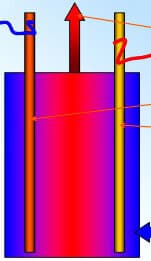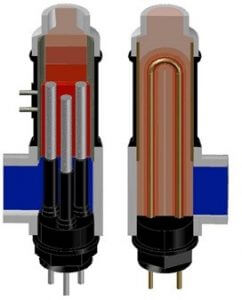OPERATING PRINCIPLE
ELLA Ionization central heating boiler operate exclusively on electricity.
At the same time, they are characterized by low power consumption, so we manage to compete with natural gas heating boilers, leaving way behind those that use LPG and resistance heating ones (nickel wire). Unlike gas-based systems, when installing and operating our central heating boilers, you will not have any additional costs with projects, authorizations, connections, etc., which end up doubling the initial price of the heating boiler.
In terms of safety, these heating boilers do not use flames, radioactive systems, or high frequency (induction) electromagnetic pulses that would endanger health or life.

As can be seen in the drawing, unlike resistance heating boilers, heating occurs from inside the water, throughout the entire volume, with the electrodes remaining cold.
The maximum absorption power of the apartment models is correlated with the standard charging capacity of the Romanian household electrical networks (approximately as much as two electric oil radiators in the case of the apartment one - E150). But due to its outstanding performance, its heating power is equivalent to the power of an ordinary 9 kW resistance heating boiler. It is important to know that the power of the ionization heating boiler increases slowly and gradually (yet not in stages) with the increase of the water temperature, from about 2 to 5 kW for the monophase heating boiler, thus avoiding the starting shocks characteristic in resistance heating devices.
The thermal agent is distilled water or rainwater. The use of any antifreeze or water from wells with increased salinity or hardness is strictly prohibited.
– Working temperature: up until 70°C (recommended: 55°C)
– Work pressure: 0 - 1.5 bar
?
Question: How can the efficiency of ELLA central heating boilers be superior by approx. 30% to resistance heating ones if the efficiency of resistance heating boilers reaches 99%? Are you saying it is superunitary?
Regarding the claimed efficiency of 99% of resistance heating boilers:
We have received this question several times from people who have technical training, but who unfortunately do not use this knowledge, blindly believing the manufacturers of resistance heating boilers. Let’s start with a practical example that cannot be denied, only explained. Everyone knows Calgon’s advertisements, where due to limescale damage, the resistance of the washing machine burns quickly. But why does this keep happening? It’s because the build-up prevents the transmission of heat from the resistance to water. As a result, the temperature of the resistance increases, causing its life span to decrease. We notice the same thing if we leave the electric kettle without water - the uncontrolled rise in temperature until burning. That is, the resistance coil works by absorbing the same electricity, but water heating occurs more slowly (a phenomenon also observed in electric heating boilers) due to that build-up. In technical language, this is called a decrease in efficiency.
?
Question: Where does some of the heat from the resistance go, if it is immersed in water and uses the same amount?
Answer: Towards the inside of the resistance, to increase the wire temperature above the normal one (approx. 450°C). We are open to other explanations.
Returning to the claimed yield of approx. 99% of resistance heating boilers, we will list some ignored factors which have a significant impact.
If the build-up on the outside of the heater reduces the efficiency, let's not forget the insulating sand layer inside the heater and the brass jacket between the water and the nickel wire, which are also factors that reduce the efficiency, preventing the transmission of heat in the water. By the way, even the manufacturers acknowledge that over time, the yield of the resistance decreases. Here also appears a phenomenon ignored by specialists, the water vapor barrier, which is formed on the surface of the resistance, which occurs due to the high temperature of the resistance and, consequently, the boiling of water. By immersing a resistance in the water, this phenomenon becomes visible. Therefore, it is another barrier to the heat produced by resistance. Another fact that explains the increase in efficiency in ionization heating, is that here WATER IS A RESISTANCE and is heated from the inside without barriers, deposits, and classical resistance. Multiple tests have shown that ELLA central heating boilers have a higher efficiency by min. 25% compared to the classic ones. It is out of the question to say that their efficiency is 124%, because it would contradict the laws of physics. Consequently, the real efficiency of the resistance heating boilers does not exceed 73%.

